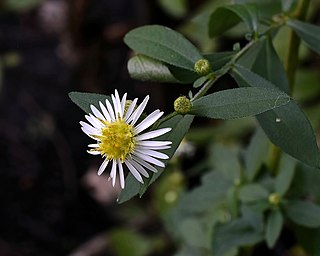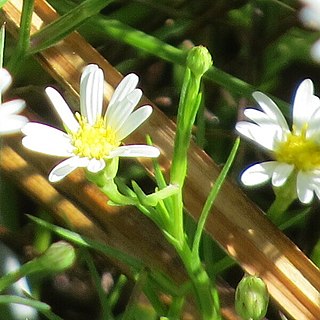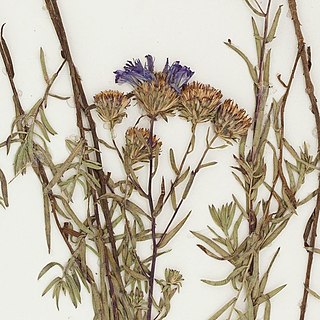Related Research Articles

Solidago, commonly called goldenrods, is a genus of about 100 to 120 species of flowering plants in the family Asteraceae. Most are herbaceous perennial species found in open areas such as meadows, prairies, and savannas. They are mostly native to North America, including Mexico; a few species are native to South America and Eurasia. Some American species have also been introduced into Europe and other parts of the world.

Symphyotrichum novae-angliae is a species of flowering plant in the aster family (Asteraceae) native to central and eastern North America. Commonly known as New England aster, hairy Michaelmas-daisy, or Michaelmas daisy, it is a perennial, herbaceous plant usually between 30 and 120 centimeters tall and 60 to 90 cm wide.

Oclemena is a small genus of North American flowering plants in the tribe Astereae within the family Asteraceae.

Symphyotrichum is a genus of over 100 species and naturally occurring hybrids of herbaceous annual and perennial plants in the composite family, Asteraceae, most which were formerly treated within the genus Aster. The majority are endemic to North America, but several also occur in the West Indies, Central and South America, as well as in eastern Eurasia. Several species have been introduced to Europe as garden specimens, most notably New England aster and New York aster.

Astereae is a tribe of plants in the family Asteraceae that includes annuals, biennials, perennials, subshrubs, shrubs, and trees. They are found primarily in temperate regions of the world. Plants within the tribe are present nearly worldwide divided into over 250 genera and more than 3,100 species, making it the second-largest tribe in the family behind Senecioneae.

Symphyotrichum lateriflorum is a species of flowering plant in the aster family (Asteraceae). Commonly known as calico aster, starved aster, and white woodland aster, it is native to eastern and central North America. It is a perennial and herbaceous plant that may reach heights up to 120 centimeters and widths up to 30 centimeters.

Symphyotrichum pilosum is a perennial, herbaceous, flowering plant in the Asteraceae family native to central and eastern North America. It is commonly called hairy white oldfield aster, frost aster, white heath aster, heath aster, hairy aster, common old field aster, old field aster, or steelweed. It may reach 20 to 120 centimeters tall, and its flowers have white ray florets and yellow disk florets.

Symphyotrichum lanceolatum is a species of flowering plant in the family Asteraceae native to North America. Common names include panicled aster, lance-leaved aster, and white panicled aster. It is a perennial, herbaceous plant that may reach 1.5 meters tall or more, sometimes approaching 2 m. The lance-shaped leaves are generally hairless but may feel slightly rough to the touch on the top because of tiny bristles. The flowers grow in clusters and branch in panicles. They have 16–50 white ray florets that are up to 14 millimeters long and sometimes tinged pink or purple. The flower centers consist of disk florets that begin as yellow and become purple as they mature.

Symphyotrichum dumosum is a species of flowering plant of the family Asteraceae commonly known as rice button aster and bushy aster. It is native to much of eastern and central North America, as well as Haiti and Dominican Republic. It is a perennial, herbaceous plant that may reach a height of 1 meter.

Solidago nana is a North American plant species in the family Asteraceae, with the common names baby goldenrod and dwarf goldenrod. The species is native to deserts and mountainsides in the western United States, from the Rocky Mountains to the Great Basin in the states of Idaho, Montana, Nevada, Utah, Wyoming, Colorado, Arizona, and New Mexico.

Symphyotrichum patens, commonly known as late purple aster or spreading aster, is a perennial, herbaceous plant found in the eastern United States.

Symphyotrichum boreale is a species of flowering plant of the aster family (Asteraceae) native to North America. Commonly known as rush aster, northern bog aster, and slender white aster, it is a perennial, herbaceous plant that may reach heights of 85 centimetres.

Symphyotrichum ontarionis is a species of flowering plant in the family Asteraceae native to eastern North America. Commonly known as Ontario aster and bottomland aster, it is a perennial, herbaceous plant that may reach heights of 120 centimeters. Each flower head has many tiny florets put together into what appear as one.

Symphyotrichum racemosum is a species of flowering plant native to parts of the United States and introduced in Canada. It is known as smooth white oldfield aster and small white aster. It is a perennial, herbaceous plant in the family Asteraceae. It is a late-summer and fall blooming flower.

Symphyotrichum estesii is a species of flowering plant in the family Asteraceae, endemic to Coffee County, Tennessee. Commonly called May Prairie aster and Estes's aster, it is a perennial, herbaceous plant that may reach 30 to 85 centimeters in height. Its flowers have white ray florets and yellow disk florets. It is named in honor of botanist Dwayne Estes who discovered it in 2008.

Symphyotrichum simmondsii is a species of flowering plant of the family Asteraceae endemic to the southeastern United States. Commonly known as Simmonds' aster, it is a colony-forming herbaceous perennial.

Symphyotrichum potosinum is a species of flowering plant in the family Asteraceae native to Mexico and the U.S. state of Arizona. Commonly known as Santa Rita Mountain aster, it is a perennial, herbaceous plant that may reach heights of 15 to 45 centimeters.

Symphyotrichum turneri is a species of flowering plant in the family Asteraceae native to Durango, Mexico.

Symphyotrichinae is a subtribe of plants in the family Asteraceae containing six genera primarily of North American origin. In addition to Symphyotrichum, the largest and the type genus, the genera are Almutaster, Ampelaster, Canadanthus, Psilactis, and Sanrobertia.
References
- Botanical Society of America (1995). "Guide to Graduate Study in Botany for the United States and Canada". American Journal of Botany (Supplement). 170 (8th ed.). St. Louis: Botanical Society of America. 82 (10): 12. ISSN 1537-2197 . Retrieved 13 October 2021.
- IPNI (2020). "Semple, John Cameron". www.ipni.org. Royal Botanic Gardens, Kew; Harvard University Herbaria & Libraries; Australian National Botanic Gardens . Retrieved 25 October 2020.
- Lotosky, W. (22 May 2012). "The Last Classically Trained Cytotaxonomist in North America". Ontario: University of Waterloo. Archived from the original on 28 July 2021. Retrieved 28 July 2021.
- Semple, J.C. (n.d.a). "John C. Semple [profile]". www.researchgate.net. Retrieved 22 November 2021.
- Semple, J.C. (8 May 2021b). "Astereae Lab – John C. Semple". Ontario: University of Waterloo. Archived from the original on 28 June 2021. Retrieved 28 June 2021.
- Semple, J.C. (9 November 2021e). "Astereae Lab home". Ontario: University of Waterloo . Retrieved 5 December 2021.